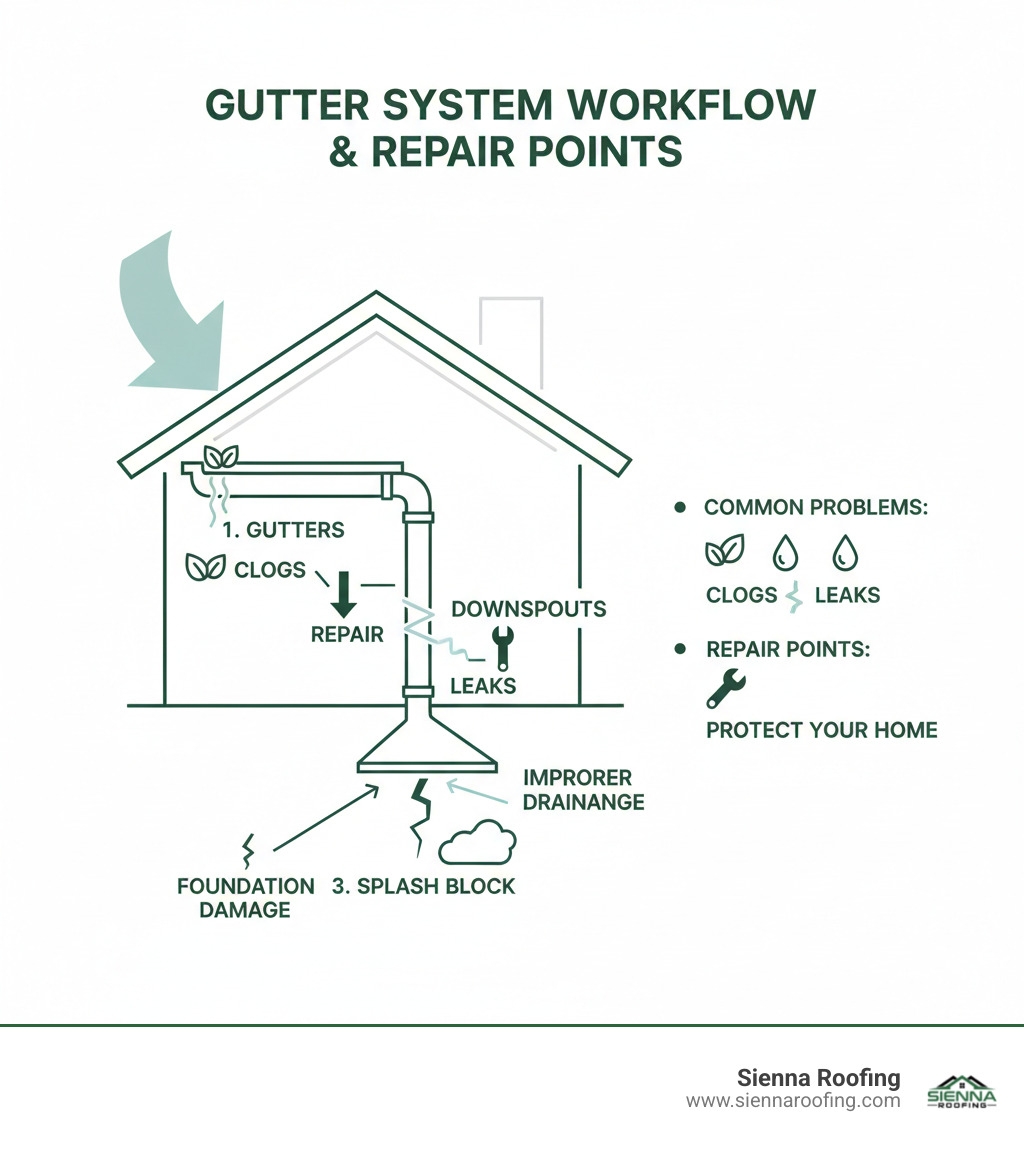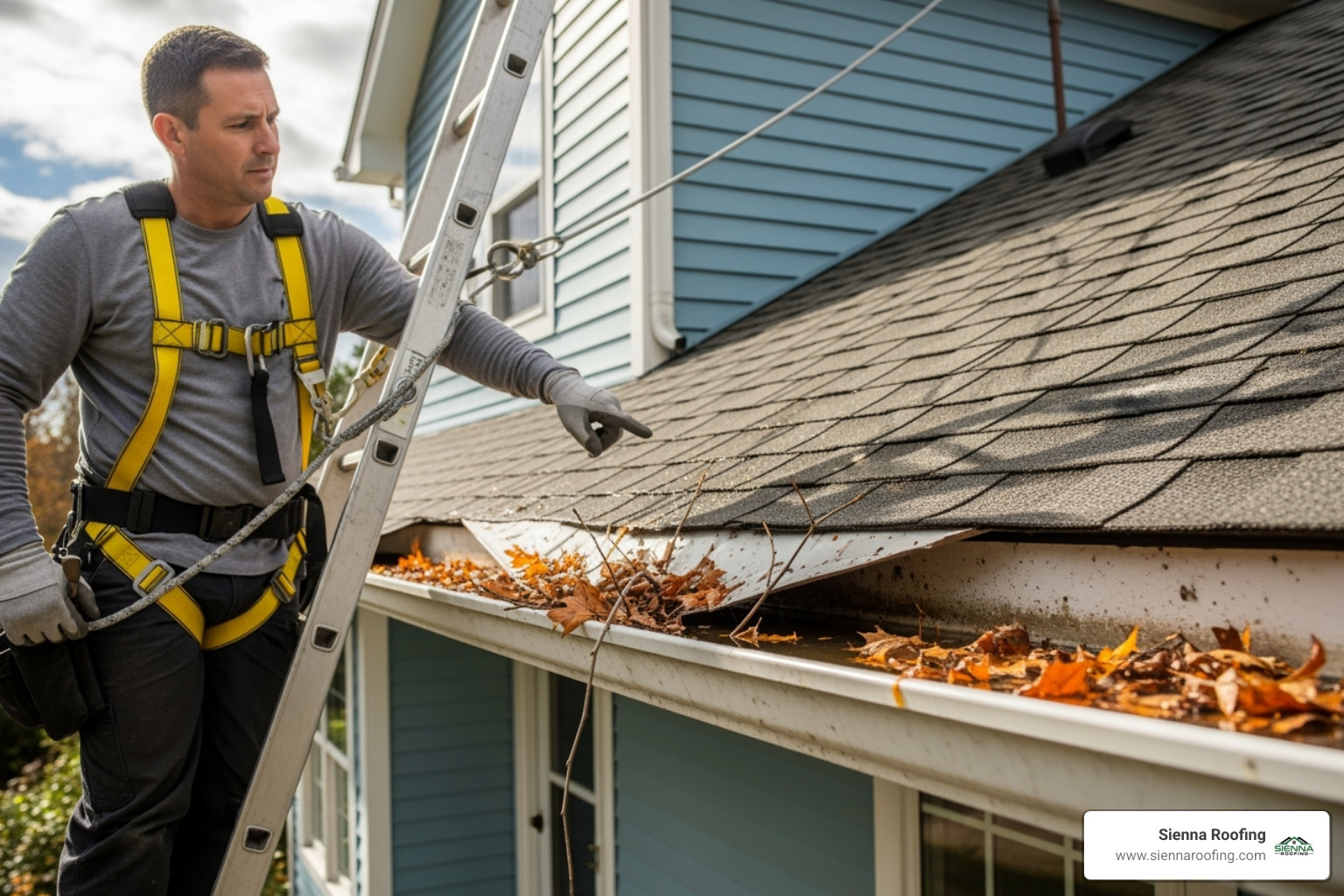Roof and guttering repairs near me: Your 7 Ultimate Fixes
Your Ultimate Guide to Roof and Gutter Repair
Roof and guttering repairs near me are essential for protecting your home from costly water damage. A properly functioning roof and gutter system is your home’s primary defense against water damage, protecting everything from your foundation to your fascia. When you need reliable solutions, finding trusted professional roofing services is the first step.
Quick Answer for Immediate Help:
- Signs you need repairs: Standing water in gutters, sagging sections, water stains on walls, or puddles around your foundation.
- Emergency contacts: Licensed roofing contractors with 24/7 availability.
- Typical costs: Minor repairs range from $150-$500, while a full gutter replacement can cost $1,600-$6,000+, depending on the material.
- Best materials: Aluminum (most common), copper (longest lasting), and vinyl (budget-friendly).
- When to call pros: Any repair involving heights, electrical work, or potential structural damage.
When you notice issues, it’s crucial to act quickly. Standing water, sagging gutters, water pouring over the sides, and puddles around your foundation are clear warning signs that need immediate attention. The best way to avoid excessive gutter-repair costs is to make gutter cleaning a priority and address problems early.
This guide simplifies your search for reliable contractors, providing all the information you need from identifying problems to understanding your options. We’ll break down the signs of damage, material choices, costs, and how to choose a professional for your roof and guttering repairs. For a deeper dive into replacing your roof, see our complete roof replacement guide.
I’m Andre Castro, CEO and founder of Sienna Roofing & Solar, with over five years of experience in the roofing industry and a Construction Management background from Texas A&M University. Having personally overseen countless roof and guttering repairs near me projects throughout the Houston Metro area, I understand the unique challenges our local climate presents to homeowners seeking reliable repair solutions.

Why Your Roof and Gutters are Your Home’s First Line of Defense
Your roof and gutters work as a powerful team, quietly protecting your home 24/7 from one of nature’s most destructive forces: water. When functioning properly, this dynamic duo handles thousands of gallons of water each year, directing every drop safely away from your foundation, walls, and landscaping. But when this system fails, even minor issues can snowball into expensive disasters that no homeowner wants to face.
Professional roof and guttering repairs near me become essential when you realize that your home’s water management system is more than just metal channels and shingles – it’s your property’s insurance policy against water damage. For Houston-area homeowners dealing with our intense storms and heavy rainfall, having a reliable system isn’t just nice to have; it’s absolutely critical.
The Critical Role of a Functional Gutter System
Your gutter system does far more heavy lifting than most homeowners realize. Water diversion is its primary job – collecting rainwater as it cascades off your roof and channeling it through a carefully designed path away from your home’s most vulnerable areas.
Foundation protection represents the most critical function of your gutters. Without proper water diversion, thousands of gallons of rainwater can pool around your home’s base during each storm, creating hydrostatic pressure that cracks foundations and causes structural damage costing tens of thousands to repair.
Your gutters also play a vital role in preserving your roof’s lifespan. By preventing water from backing up under shingles or pooling on roof surfaces, they protect your roof decking, fascia boards, and interior from moisture damage that leads to rot, mold, and premature aging.
The system extends its protective reach to your home’s exterior as well. Preventing siding damage keeps water from streaming down your walls, which would otherwise cause paint to peel, wood to rot, and unsightly staining that diminishes your home’s curb appeal and value.
The High Cost of Neglect: What Happens When Gutters Fail
Ignoring gutter problems is a high-stakes gamble with your home’s structural integrity. The consequences of neglect compound quickly, turning manageable repairs into major reconstruction projects.
Foundation damage tops the list of expensive consequences. When gutters fail to divert water properly, soil around your foundation becomes saturated, leading to expansion and contraction cycles that create foundation cracks and structural damage. These repairs often require specialized contractors and can easily cost $20,000 or more.
Basement flooding becomes a real threat when water isn’t properly channeled away from your home. Once water finds its way into your basement or crawl space, you’re looking at damaged belongings, potential electrical hazards, and the perfect breeding ground for mold and mildew growth, which the U.S. Environmental Protection Agency warns can pose significant health risks.
The ripple effects continue upward to your roof and exterior walls. Overflowing gutters saturate fascia boards and soffits, creating ideal conditions for pest infestations as termites and other insects are attracted to the rotting wood. Meanwhile, constant moisture exposure causes siding and paint damage that requires expensive refinishing or replacement.
New rain gutters protect your home and help you avoid more expensive repairs related to roof or foundation water damage – a fact that makes gutter maintenance one of the smartest investments you can make in your property.
How Local Climate Affects Your Roof and Gutter Needs
Living in the Houston area means your roof and gutter system faces unique challenges that systems in milder climates never encounter. Our weather doesn’t just test your gutters – it puts them through an annual gauntlet of extreme conditions.
Heavy rainfall defines much of our weather pattern, with intense storms capable of dumping several inches of rain in just a few hours. During hurricane season, we face the double threat of torrential downpours combined with high winds that can tear gutters from their mountings or fill them with debris in minutes.
The constant debris accumulation from our beautiful but prolific trees means gutters fill with leaves, twigs, and seeds faster than in many other regions. Add our intense UV exposure from the Texas sun, and you have conditions that can make inferior gutter materials brittle and prone to cracking within just a few years.
These climate factors make proper sizing and material selection crucial for Houston-area homes. Your gutter system must be engineered not just for average rainfall, but for the extreme weather events that define our region. When searching for professional roofing contractors who understand these local challenges, choose experts familiar with our unique climate demands and the robust solutions they require.
Spotting Trouble: 7 Telltale Signs You Need Roof and Guttering Repairs Near Me
Even the most robust roof and gutter systems will eventually show signs of wear and tear. Being vigilant and knowing what to look for can save you from extensive damage and costly repairs down the line. We recommend regular visual inspections, especially after severe weather. If you notice standing water in your gutters or see them sagging, you might need new gutters to ensure your home is fully protected in every kind of weather.

Here are seven telltale signs that it’s time to call in the professionals for roof and guttering repairs near me:
1. Visible Cracks, Holes, or Rust Spots
Take a peek at your gutters (safely, of course!). Do you see any small cracks, pinholes, or areas of rust? These seemingly minor imperfections are like tiny invitations for water to escape the system. Over time, these small issues become bigger leaks, allowing water to drip onto your fascia, siding, or directly onto your foundation. For metal gutters, rust spots indicate material deterioration and a weakening of the system’s integrity. Inspecting for these damages after storms is particularly important.
2. Sagging or Pulling Away from the House
Gutters should always maintain a consistent, slight slope towards the downspouts. If you notice sections of your gutters sagging, bending, or pulling away from the fascia board, it’s a clear sign of trouble. This usually indicates that the fasteners have loosened, or the gutters are overburdened with heavy debris and standing water. The weight can also cause the fascia board itself to rot, leading to an even larger repair job. Sagging gutters cannot effectively channel water, leading to overflows.
3. Water Damage on or Around Your Home
This is often one of the most noticeable signs. If you see water stains on your home’s siding, streaks of dirt, or peeling paint directly below your gutters, it means water is overflowing or leaking from the system. Similarly, patches of mold or mildew on the exterior walls, especially near the roofline, are telltale signs that water isn’t being properly channeled away. These indicate that moisture is constantly present where it shouldn’t be, potentially causing structural damage over time. For any signs of water damage on your roof, we always recommend a professional roof leak inspection.
4. Puddles or Erosion Around Your Foundation
After a rain shower, take a walk around your home. If you consistently find puddles of water accumulating around your foundation or notice signs of soil erosion (like small trenches), your gutters and downspouts aren’t doing their job. This is the most critical sign of potential foundation damage. Improper drainage can lead to serious issues, including basement flooding, cracks in your foundation, and structural instability. Make sure your downspouts are properly extended and splash blocks are correctly aligned to direct water far from your home.
5. Standing Water or Debris in Gutters
Gutters are designed to move water, not hold it. If you see standing water in your gutters long after the rain has stopped, it indicates a clog or an improper pitch. Clogs, often caused by leaves, twigs, and other organic debris, prevent water from flowing freely to the downspouts. This standing water creates a breeding ground for mosquitoes and can add significant weight to the gutters, leading to sagging and eventual detachment. Regular cleaning is key here!
6. Peeling Paint and Rotting Wood
The fascia boards that your gutters are attached to are highly susceptible to water damage. When gutters overflow or leak, water constantly runs over and behind them, saturating the wood. The first sign is often peeling or bubbling paint along the roofline. If left unaddressed, this persistent moisture will lead to wood rot, compromising the structural integrity of your roof’s edge and creating a much more expensive repair that involves replacing both the gutters and the fascia boards.
7. Loose Fasteners or Finding Screws on the Ground
Your gutter system is held in place by fasteners like screws, spikes, or hidden hangers. If you start finding these on the ground below your gutters after a storm or windy day, it’s a definitive red flag that the system is coming loose. Thermal expansion and contraction, combined with the immense weight of water and debris, can work these fasteners out over time. A loose gutter is an unsafe gutter, at risk of detaching completely during the next heavy downpour and potentially damaging your siding or landscaping on its way down.
Your Gutter System Explained: Materials, Types, and Upgrades
When it comes to roof and guttering repairs near me, understanding your options can save you both time and money. Think of your gutter system as your home’s circulatory system – every component plays a vital role in keeping water flowing where it should. Whether you’re considering repairs or a complete overhaul, knowing the ins and outs of materials, installation methods, and protective accessories will help you make the smartest choice for your Houston-area home.
The beauty of modern gutter systems lies in their variety. From budget-friendly vinyl to premium copper that ages like fine wine, there’s a solution for every home and budget. But here’s the thing – not all gutters are created equal, especially when you’re dealing with our Texas weather extremes.
Choosing Your Gutter Material: A Comparative Look
Selecting the right material for your gutters isn’t just about upfront costs – it’s about finding the sweet spot between durability, maintenance, and your budget. Each material brings its own personality to your home’s protection system.
| Material | Average Cost/Foot (Installed) | Lifespan | Pros | Cons |
|---|---|---|---|---|
| Aluminum | $8-12 | 15-20 years | Lightweight, rust-resistant, affordable, easy installation | Can dent easily, expansion/contraction issues |
| Copper | $15-25 | 50+ years | Beautiful patina, extremely durable, adds home value | High upfront cost, requires professional installation |
| Vinyl | $4-8 | 10-15 years | Most affordable, DIY-friendly, won’t rust or dent | Becomes brittle in extreme temperatures, limited color options |
| Steel | $10-16 | 20-25 years | Very strong, handles heavy snow/ice well | Prone to rust, heavier installation required |
Aluminum gutters dominate the Houston market for good reason. They strike that perfect balance between cost and performance that most homeowners love. They won’t rust like steel, they’re light enough for most homes, and they come in colors that actually stay looking good under our intense Texas sun.
Copper gutters are the luxury sports car of the gutter world. Yes, they cost significantly more upfront – sometimes five to six times more than aluminum – but they’ll likely outlast your mortgage. That gorgeous green patina that develops over time? That’s not damage, that’s character. Plus, copper can last over 50 years with minimal maintenance.
Vinyl gutters appeal to the DIY crowd and budget-conscious homeowners. They’re perfect for that weekend warrior who wants to tackle installation themselves. However, our Texas heat can make them brittle over time, and those extreme temperature swings we experience can cause cracking.
Steel gutters bring serious strength to the table. If you live in an area prone to severe weather or have large trees that drop heavy branches, steel might be your best friend. The trade-off? They require more maintenance to prevent rust, especially in our humid climate.
Seamless vs. Sectional Gutters: Which is Right for You?
Here’s where the rubber meets the road – or rather, where the water meets the gutter. The installation method you choose can dramatically impact your system’s performance and longevity.
Seamless gutters are the gold standard for most homes. These custom-fabricated beauties are made on-site using specialized equipment that creates long, continuous runs with no joints except at corners and downspouts. Think of them as the custom suit of the gutter world – they fit perfectly because they’re made specifically for your home.
The biggest advantage? Fewer leaks. Every seam in a gutter system is a potential failure point. By eliminating most seams, seamless gutters dramatically reduce the chance of leaks developing over time. They also look cleaner and more professional, which your neighbors will definitely notice.
The downside? You can’t install them yourself. The equipment required to form seamless gutters costs tens of thousands of dollars, so you’ll need professional installation. But honestly, that’s often a blessing in disguise – proper installation is crucial for any gutter system’s success.
Sectional gutters are the traditional approach, using pre-made sections that connect together with joints and sealants. They’re readily available at home improvement stores, making them perfect for DIY enthusiasts or quick repairs. If a section gets damaged, you can replace just that piece rather than an entire run.
However, all those connection points mean more opportunities for leaks to develop. Over time, thermal expansion and contraction can stress these joints, and Houston’s weather swings can accelerate this process. Regular maintenance becomes even more critical with sectional systems.
The Unsung Heroes: Downspouts, Splash Blocks, and Gutter Guards
Your gutters might get all the attention, but the supporting cast members are equally important for a properly functioning system. These components work together to ensure water doesn’t just leave your roof – it gets deposited safely away from your foundation.
Downspouts are your gutter system’s workhorses. They need to be properly sized to handle your roof’s water volume during heavy rains. A good rule of thumb: one downspout can handle about 600-800 square feet of roof area. Undersized downspouts create bottlenecks that lead to overflows, while properly sized ones ensure smooth water flow even during Houston’s legendary downpours.
The placement of downspouts matters tremendously. They should direct water at least 6-10 feet away from your foundation, and the path should slope away from your home. Corner locations work best because they minimize the visual impact while maximizing drainage efficiency.
Splash blocks might look like simple concrete or plastic rectangles, but they’re preventing thousands of dollars in foundation damage. Without them, water shoots out of downspouts and immediately starts eroding soil around your foundation. Quality splash blocks channel water away while preventing that erosive action that can undermine your home’s stability.
Gutter guards represent the biggest advancement in gutter technology in recent decades. These systems – whether mesh screens, solid covers with small openings, or brush-style inserts – dramatically reduce the debris that enters your gutters. In a city surrounded by trees like Houston, they can be absolute game-changers.
Are gutter guards worth the investment? For most homeowners, absolutely. They reduce cleaning frequency from twice yearly to once every few years. They also prevent the dangerous clogs that can cause water to back up under your shingles. While they add to upfront costs, they typically pay for themselves within a few years through reduced maintenance needs.
The key is choosing the right type for your situation. Homes surrounded by pine trees need different solutions than those dealing primarily with large deciduous leaves. A quality contractor can help you select the system that matches your specific debris challenges.
Even the best gutter guards don’t eliminate maintenance entirely – they just make it much more manageable. You’ll still need occasional cleaning and inspection, but you’ll spend less time on ladders and more time enjoying your weekends.




